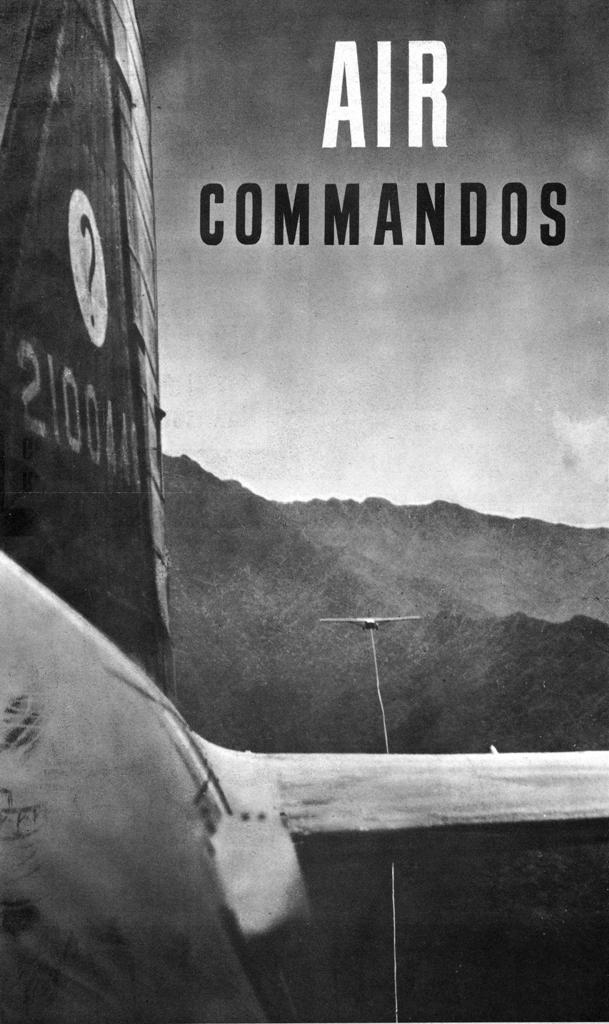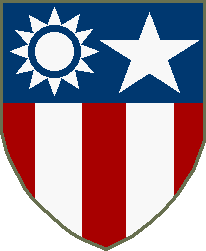 Gen. Wingate pointing to map, and Col. Cochran, right, brief American and British officers on the invasion plans.
Gen. Wingate pointing to map, and Col. Cochran, right, brief American and British officers on the invasion plans.

|
The place was Burma - some 200 miles behind the Japanese lines. The time - April, 1944. And the operation was a repeat - the second successful skyborne invasion of this territory within two months. In each case the pattern had been the same: spot open spaces from the air, send in glider-borne engineers and equipment to hack an airstrip from the brush, and within a matter of hours, fly in troops to harass the enemy and his lines of communication. In the spring of 1943 Maj. Gen. Orde C. Wingate, later killed in a Burma plane crash, proved that columns operating behind Japanese lines could be supplied by air. With air supply assured, why not invade by air? The First Air Commando Force of the AAF was created for that job. Its organizers were Colonels Philip G. Cochran and John R. Alison. It started with conferences in Washington, England, and India. Working day and night for seven months, the men in charge faced every problem that could arise before an invading army. No one commander was given direct charge of the entire undertaking. Success of the operation depended on cooperation of the various British and American army and air units involved. Besides the First Air Commando Force, there were the British Army unit under Lieut. Gen. W. J. Slim, the Indian forces under Gen. Wingate, the Tactical Air Force under Air Marshal Sir John Baldwin, and the Troop Carrier Command under Brig. Gen. William D. Old, U. S. Army. The general plan called for the Air Commando Force to fly in several units of Gen. Wingate's forces. One unit was to march in from the north. Gen. Wingate's forces selected two sites for secret landing grounds. In keeping with the joint United States-British effort, they were called Broadway and Piccadilly. Detailed loading plans were made, based on the use of the two fields. Bulldozers were loaded aboard the first night's gliders to help prepare the field for the C-47 transports to follow. D-Day was March 5. To avoid all chance of drawing enemy attention it was decided that neither Broadway nor Piccadilly would be photographed preceding the operation. But on D-Day Cochran on a hunch ordered a photo-reconnaissance. Fifteen minutes before take-off time, with gliders loaded and all personnel briefed either for Broadway or Piccadilly, enlarged photos of the two sites arrived. They showed Piccadilly hopelessly obstructed. Large tree trunks had been dragged to all parts of the field, all but one small portion of which might have been mined. But despite the possibility that the Jap might know, and was ready for what had to be a surprise, despite the doubt and confusion created by double briefing, it was determined to go ahead - all gliders to Broadway. Starting at 6:12 p.m. twenty-six transports carrying double-tow left in the first wave, taking off at five and ten minute intervals. Of 54 gliders dispatched that night and not recalled, 37 arrived at Broadway. Eight landed west of the Chindwin River in friendly territory. Nine others landed beyond the east bank, in enemy territory. Thirty men were killed and 33 injured in the landings on Broadway that first night. Almost all the gliders were damaged or destroyed in the landing. Four bulldozers were landed, one being put out of commission. A radio set was put into operation and the base from which the gliders had taken off was signaled to stop a second wave of single and double-tow gliders already in flight. All but one double-tow were recalled before they reached the target area. The officer designated to superintend the field was in one of the missing gliders of the first flight. His party leader swam the Chindwin to safety. In his absence, Col. Alison took over to signal the gliders in. "We were in complete darkness because we didn't dare turn on any lights," he said. "Planes were landing at all angles, and their pilots couldn't see us any more than we could see them. Those gliders were like DC-3s, heavily loaded, landing with their motors cut off. When the gliders hit the ground, they really hit. Men were running all over the field, shouting instructions. Often those trying to help wounded men off the field would have to duck out of the path of a landing glider." More than 500 men were brought in that first night. The Airborne Engineers and all personnel not needed for other duty went to work clearing the field and filling the ditches in preparation for the next night's operation. The job was done by late afternoon of March 6. On that day a secondary field was brought into operation to relieve congestion at Broadway and the same night sixty-two C-47 sorties were flown into Broadway by the Troop Carrier Command and all casualties were evacuated. A man could be injured in the middle of the afternoon and be in a hospital in India at night. As fast as the three airborne units of Gen. Wingate's force were landed, they were split up into columns and moved out to fulfill their appointed missions. No enemy reaction was found until March 8 when the Air Commando Force discovered the Jap air force was being reinforced. Twenty P-51s and nine B-25s destroyed ninety-two Jap planes in raids on enemy airfields. Broadway remained immune to Japanese attack until March 13. The enemy blows, however, failed to prevent the routine fly-in of supplies to the stronghold and the regular supply-dropping sorties by the Troop Carrier Command. |
 Gen. Wingate pointing to map, and Col. Cochran, right, brief American and British officers on the invasion plans.
Gen. Wingate pointing to map, and Col. Cochran, right, brief American and British officers on the invasion plans.
|
 Glider tow ropes all sorted are ready to be hooked to gliders and tow planes for the evening take-off.
Glider tow ropes all sorted are ready to be hooked to gliders and tow planes for the evening take-off.
|
 Missouri mule objects to his first air trip as Wingate's troops and supplies are being loaded into transports.
Missouri mule objects to his first air trip as Wingate's troops and supplies are being loaded into transports.
|
 A C-47 tow plane in one of the most delicate air operations: snatching a glider off the ground while in flight.
A C-47 tow plane in one of the most delicate air operations: snatching a glider off the ground while in flight.
|
 Daylight after the night landing. Logs and other natural obstacles smashed gliders as they landed from all angles.
Daylight after the night landing. Logs and other natural obstacles smashed gliders as they landed from all angles.
|
 With bulldozers and by hand men cleared the invasion field "Broadway" for the awaiting troop transports.
With bulldozers and by hand men cleared the invasion field "Broadway" for the awaiting troop transports.
|
 American and British soldiers had to drive Japs from Nip machine gun nests built right on the "Broadway" runway.
American and British soldiers had to drive Japs from Nip machine gun nests built right on the "Broadway" runway.
|
 B-25s with the 5-stripe insignia of the Air Commandos hit Jap stores and supply depots used against the invasion.
B-25s with the 5-stripe insignia of the Air Commandos hit Jap stores and supply depots used against the invasion.
|

AIR COMMANDOS China-Burma-India Theater of World War II Original U.S. Army "Newsmap" shared by Charles Peterson Copyright © 2008 Carl Warren Weidenburner |